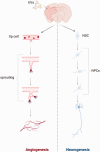The age-associated decline in neuroplasticity and its implications for post-stroke recovery in animal models of cerebral ischemia: The therapeutic role of extracellular vesicles
- PMID: 40770923
- PMCID: PMC12331653
- DOI: 10.1177/0271678X251365020
The age-associated decline in neuroplasticity and its implications for post-stroke recovery in animal models of cerebral ischemia: The therapeutic role of extracellular vesicles
Abstract
Older individuals are typically more susceptible to stroke, and age-related differences in brain plasticity significantly affect recovery and treatment responses following cerebral ischemia and traumatic brain injury. Extracellular vesicles (EVs) have emerged as promising diagnostic and therapeutic tools due to their role in intercellular communication and ability to cross the blood-brain barrier. While EVs hold potential in promoting brain repair, their efficacy is influenced by donor age-those derived from young stem cells exhibit more regenerative profiles, whereas aged donor EVs may carry senescence-related signals that impede recovery. Emerging therapies, including senolytics, exosome-based approaches, and immune modulation, aim to enhance post-stroke repair, yet a substantial translational gap persists, especially in adapting these strategies to the aged brain. Differences in immune responses, neurovascular integrity, and repair mechanisms between young and aged individuals further complicate therapeutic development. Incorporating aged animal models in preclinical research is thus essential for ensuring the relevance and safety of interventions in elderly patients. These findings underscore the need for age-tailored strategies that reflect the unique biological landscape of aging, paving the way for more effective treatments for stroke and related neurological conditions in older adults.
Keywords: Aging; behavioural recovery; extracellular vesicles; mesenchymal stem cell; stroke.
Conflict of interest statement
The author(s) declared no potential conflicts of interest with respect to the research, authorship, and/or publication of this article.
Figures


Similar articles
-
Emerging nanoparticle-based strategies to provide therapeutic benefits for stroke.Neural Regen Res. 2025 Jun 19. doi: 10.4103/NRR.NRR-D-24-01492. Online ahead of print. Neural Regen Res. 2025. PMID: 40536921
-
Management of urinary stones by experts in stone disease (ESD 2025).Arch Ital Urol Androl. 2025 Jun 30;97(2):14085. doi: 10.4081/aiua.2025.14085. Epub 2025 Jun 30. Arch Ital Urol Androl. 2025. PMID: 40583613 Review.
-
Brain-derived extracellular vesicles: A promising avenue for Parkinson's disease pathogenesis, diagnosis, and treatment.Neural Regen Res. 2026 Apr 1;21(4):1447-1467. doi: 10.4103/NRR.NRR-D-24-01262. Epub 2025 Apr 29. Neural Regen Res. 2026. PMID: 40313118
-
Type 1 Diabetes: A Guide to Autoimmune Mechanisms for Clinicians.Diabetes Obes Metab. 2025 Aug;27 Suppl 6(Suppl 6):40-56. doi: 10.1111/dom.16460. Epub 2025 May 15. Diabetes Obes Metab. 2025. PMID: 40375390 Free PMC article. Review.
-
The Black Book of Psychotropic Dosing and Monitoring.Psychopharmacol Bull. 2024 Jul 8;54(3):8-59. Psychopharmacol Bull. 2024. PMID: 38993656 Free PMC article. Review.
References
-
- Benjamin EJ, Muntner P, Alonso A, et al. Heart disease and stroke statistics-2019 update: a report from the American heart association. Circulation 2019; 139: e56–e528. - PubMed
-
- Fjell AM, Walhovd KB. Structural brain changes in aging: courses, causes and cognitive consequences. Rev Neurosci 2010; 21: 187–221. - PubMed
Publication types
LinkOut - more resources
Full Text Sources
Miscellaneous

